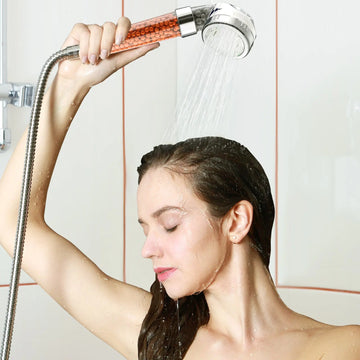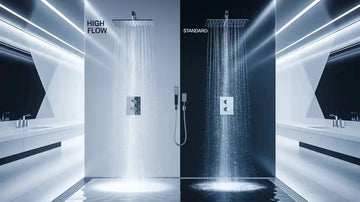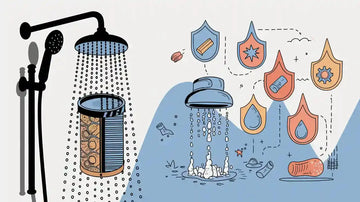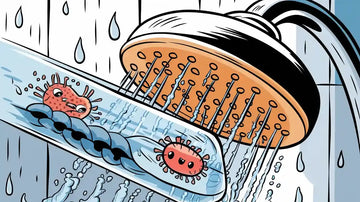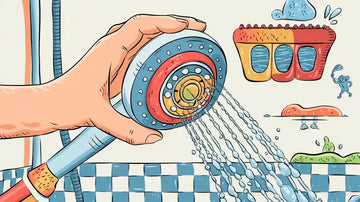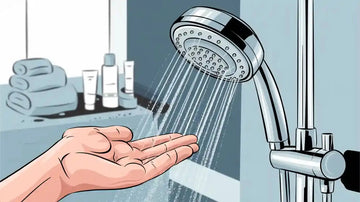When picking a shower head, it's important to know the difference between high flow and standard types. High flow shower heads spray water faster, often above the U.S. limit of 2.5 gallons per minute (gpm). Some can even reach up to 5.5 gpm. Standard shower heads usually stay at 2.5 gpm or less to follow the rules.
This difference matters because water speed and pressure change how showers feel. For example, states like California and New York lowered the limit to 1.8 gpm. This reduces water pressure by 28%. Understanding these facts helps you choose a shower head that works well, feels good, and saves water.
Key Takeaways
High flow shower heads spray water faster, over 2.5 gallons a minute. They give a strong, spa-like shower experience.
Standard shower heads use 2.5 gallons or less per minute. They save water and are good for your budget and the planet.
Check your home's water pressure before picking a shower head. High flow ones need strong pressure, but standard ones work with lower pressure.
Look for features like spray settings you can adjust and nozzles that are easy to clean. These make showers better.
Clean your shower head every 1-2 months to keep it working well and flowing properly.
What is a High Flow Shower Head?
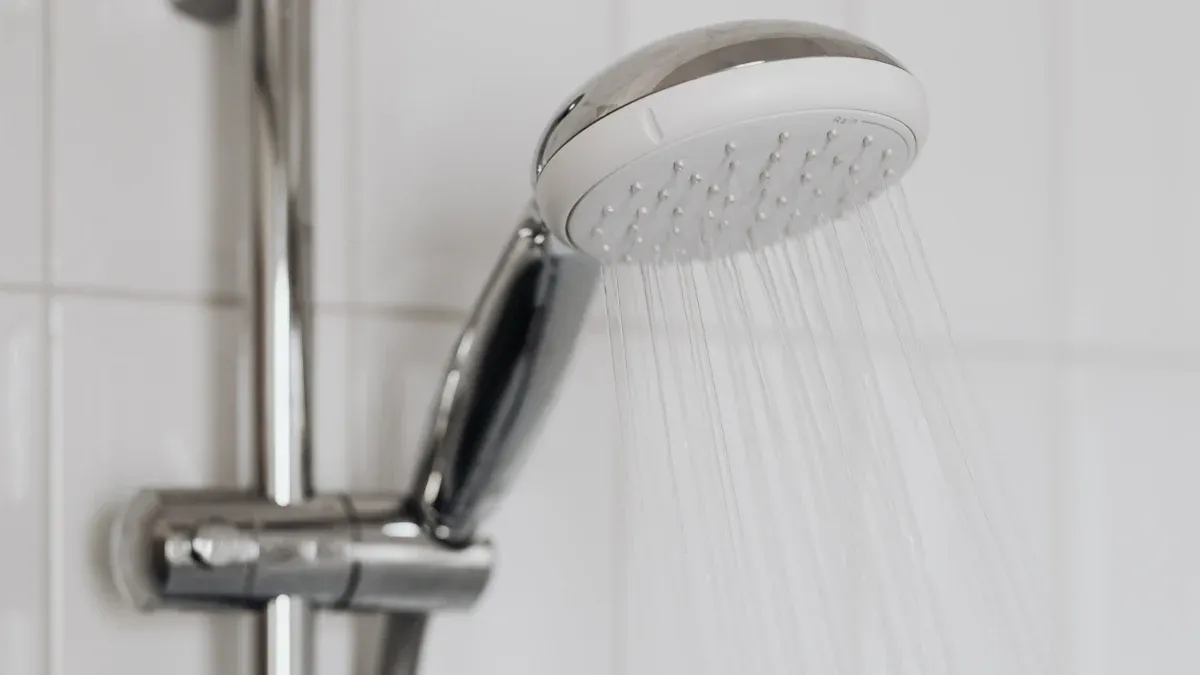
Definition and Features
A high flow shower head lets water come out faster. It often goes over the U.S. limit of 2.5 gallons per minute (gpm). These are great for people who like strong showers.
You can find high flow shower heads in different styles, like handheld or fixed ones. Many have special spray options, like massage or rain settings, to make showers more fun. Some also have tools to keep water flow steady, even if pressure changes.
Benefits of High Flow Shower Heads
High flow shower heads have many perks for your daily showers. They give stronger water streams, which rinse shampoo and soap better. This is helpful if you have thick hair or want quicker showers.
Studies show high-pressure showers can make people take shorter showers. This might save water, even with a higher flow rate. The strong spray can also feel like a spa, making your shower more relaxing.
Typical Flow Rate and Water Pressure
High flow shower heads usually use more than 2.5 gpm. For example:
Standard shower heads use 2.5 gpm, about 25 gallons in 10 minutes.
Low-flow shower heads use 1.8 gpm, about 18 gallons in 10 minutes.
Water pressure affects how well high flow shower heads work. Many have features to keep water flow steady, even if your home’s pressure changes. This ensures every shower feels great.
Flow Rate (GPM) |
What It Means |
|---|---|
2.5 |
|
2.0 |
Highest flow rate for WaterSense products |
High flow shower heads focus on giving strong performance. They are a top pick for people who want comfort and efficiency.
What is a Standard Shower Head?
Definition and Features
A standard shower head sprays water, usually from above. It can be fixed or attached to a hose for handheld use. These shower heads follow U.S. rules, with a top flow rate of 2.5 gpm to save water.
Many standard shower heads have helpful features, such as:
A swivel joint to adjust the angle easily.
Rubber nozzles that are simple to clean.
A strong, rust-proof plastic body for long use.
Technology to keep water flow steady.
These features make standard shower heads practical and durable.
Type |
Description |
|---|---|
Standard Showerhead |
A device that sprays water from above, often fixed in place. |
Hand-held Showerhead |
A showerhead connected to a hose, usable by hand or fixed in place. |
Benefits of Standard Shower Heads
Standard shower heads have many good points. They save water while giving a nice shower. Studies show things like spray strength, coverage, and steady temperature matter to users. Standard shower heads do well in these areas, making them a favorite choice.
They also help you save money. Models using 1.5 gpm are 40% more efficient than 2.5 gpm ones. A family of three could save $72 yearly with gas heating or $129 with electric heating.
Choosing a standard shower head gives you a dependable, efficient, and budget-friendly option for daily use.
Typical Flow Rate and Water Pressure
Standard shower heads can use up to 2.5 gpm, as set by U.S. law since 1992. Some states, like California, have stricter rules, lowering the limit to 1.8 gpm. WaterSense models usually use 2.0 gpm or less, and eco-friendly ones go as low as 1.5 gpm.
Flow Rate (GPM) |
Description |
|---|---|
2.5 |
Highest flow rate allowed by U.S. law |
2.0 |
Common for WaterSense-certified shower heads |
1.8 |
Maximum flow rate in states like California |
1.5 |
Eco-friendly models for saving the most water |
These flow rates help standard shower heads save water while still giving enough pressure for a good shower.
Key Differences Between High Flow and Standard Shower Heads
Water Pressure and Flow Rate
High flow shower heads spray water with more force. They often go over the 2.5 gpm federal limit, giving a spa-like feel. Standard shower heads stay at 2.5 gpm or less. Some eco-friendly ones use as little as 1.5 gpm. This flow rate difference changes how strong the water feels.
Shower Head Type |
Maximum Flow Rate (GPM) |
|---|---|
High Flow |
2.5 |
Standard |
2.0 |
Standard |
1.8 |
Standard |
1.5 |
High flow shower heads are great for rinsing shampoo fast. They also feel like a massage. Standard shower heads are good for daily use. They mix comfort with saving water.
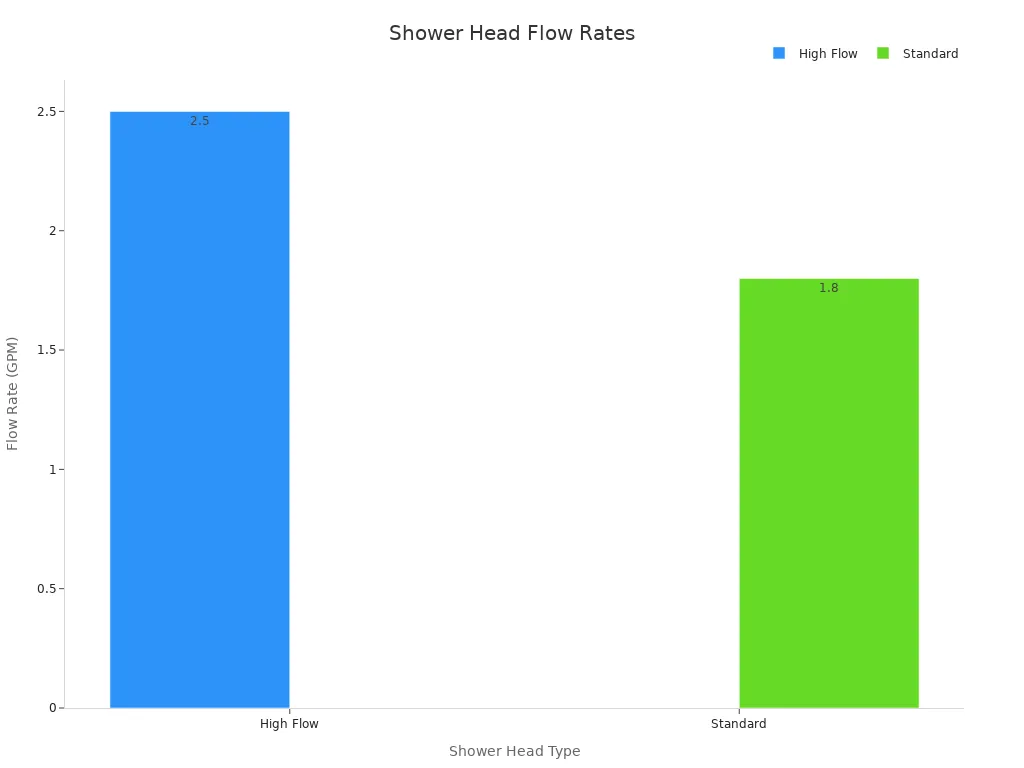
Efficiency and Water Usage
High flow shower heads use more water than standard ones. For example, they can use up to 13.2 liters per minute. Low flow shower heads cut water use by about 33%. Families using low flow models can save over 2,700 gallons of water each year.
Feature |
High Flow Shower Heads |
Low Flow Shower Heads |
|---|---|---|
Water Usage |
Uses more than 2.5 GPM, costs more |
2.5 GPM or less, saves water |
Energy Efficiency |
Higher energy bills due to more water used |
Lower energy bills with less water used |
Financial Considerations |
Raises water bills |
Saves money over time |
If saving water is important, choose standard or low flow shower heads. They use less water but still give a good shower.
Compliance with Regulations
High flow shower heads may not follow strict state rules. For example, California only allows a maximum of 1.8 gpm. Federal law has set the limit at 2.5 gpm since 1992.
If every U.S. home used 2.0 gpm WaterSense shower heads, over 260 billion gallons of water could be saved each year.
Flow Rate (GPM) |
Description |
Water Usage Impact |
|---|---|---|
2.5 |
Federal max since 1992 |
Uses about 17.2 gallons per shower |
2.0 |
Common in many models |
Moderate water use |
1.8 |
Max in some states |
28% less water, lower pressure |
1.5 |
Eco-friendly option |
40% less water than 2.5 GPM |
Standard and low flow shower heads meet these rules. They are better for the environment and save water.
Installation and Maintenance
Setting up and taking care of your shower head helps it last longer. Whether you pick high flow shower heads or standard ones, the steps are simple. You can usually do it yourself without hiring anyone.
Installation Tips
Gather Tools: Get a wrench, plumber’s tape, and a soft cloth.
Take Off the Old Shower Head: Use the wrench to unscrew it. Wrap the cloth around it to avoid scratches.
Clean the Threads: Remove old tape or dirt from the pipe threads. This helps the new shower head fit tightly.
Use Plumber’s Tape: Wrap the tape around the threads clockwise. This stops leaks.
Put On the New Shower Head: Screw it on by hand. If needed, gently tighten it with the wrench, but don’t overdo it.
Tip: Before installing high flow shower heads, check if your state allows them. Some places have strict rules about water flow limits.
Maintenance Advice
Taking care of your shower head keeps it working well. Try these tips:
Clean the Nozzles: Rub the nozzles with your fingers or a soft brush to clear any blockages.
Soak in Vinegar: Take off the shower head and soak it in vinegar for an hour. This removes hard water buildup.
Check for Leaks: Look at the connections often. Tighten them or add plumber’s tape if you see leaks.
Change Filters: If your shower head has a filter, like the Cobbe DS Filter Shower Head, replace it as the maker suggests.
Note: Low flow shower heads might need less cleaning since they use less water. Still, regular checks are important.
By installing and maintaining your shower head properly, you’ll get better water pressure and make it last longer. Follow these steps to enjoy a great shower every day.
Pros and Cons of High Flow and Standard Shower Heads
Advantages and Disadvantages of High Flow Shower Heads
High flow shower heads give a fancy shower experience. They spray water strongly, helping rinse shampoo or soap fast. This is great for thick hair or if you like spa-like showers. Many high flow models have different spray options, like massage or rain, for a custom feel.
But, these shower heads use more water. They often go over 2.5 gallons per minute, raising water bills. In states like California, they might not meet water rules. Using more water also makes them less eco-friendly.
Tip: Want high flow benefits but worry about water use? Choose models with flow restrictors.
Advantages and Disadvantages of Standard Shower Heads
Standard shower heads are made to save water. They use less water, staying under 2.5 gallons per minute. Eco-friendly ones can go as low as 1.5 gallons per minute. These help save water and lower energy bills.
However, standard shower heads may not feel as strong as high flow ones. If you like powerful showers, these might not satisfy you. In homes with low water pressure, they may not work as well.
Note: Standard shower heads are perfect if you want to save water and money while keeping basic features.
How to Pick the Best Shower Head for You
Things to Think About
Choosing a shower head depends on a few key things. First, check your home's water pressure. High flow shower heads need strong pressure. Standard ones work fine with lower pressure.
Next, think about saving water. Many shower heads now have tools like flow restrictors. These help use less water but still work well. They are great for families who care about the environment.
Your personal likes also matter. If you love fancy showers, pick one with spray options like rain or massage. If saving water is more important, choose a standard shower head with a lower flow rate.
Lastly, look at design and features. The color and shape can make your bathroom look better. Easy-to-clean nozzles and adjustable angles can make your shower easier to use.
Thing to Consider |
How It Affects Your Shower Experience |
|---|---|
Water spray strength |
Changes how good and quick your shower feels |
Spray coverage |
Helps you feel clean and happy |
Extra features |
Makes showers more enjoyable and worth the cost |
Picking between high flow and standard shower heads depends on your needs. High flow shower heads give strong, spa-like sprays. Standard ones save water and lower costs. Decide what matters more—comfort or saving water. For a refreshing and powerful shower, choose high flow. To cut water use and bills, go with standard. Pick the one that fits your habits and preferences best.
FAQ
What makes high flow and standard shower heads different?
High flow shower heads spray water harder and faster, often over 2.5 gallons per minute. Standard shower heads use less water, staying at or below 2.5 gallons per minute. Choose based on whether you want stronger showers or to save water.
Can high flow shower heads help save water?
Yes, they might! High flow shower heads use more water but can shorten shower time. This may balance water use. Some models have flow restrictors to save water while keeping good pressure.
Are high flow shower heads allowed everywhere?
No, some states like California and New York have stricter rules. They limit flow rates to 1.8 gallons per minute. Check your state’s laws before buying a high flow shower head.
How often should you clean a shower head?
Clean your shower head every 1-2 months. This stops mineral buildup and keeps it working well. Soak it in vinegar for an hour, then gently scrub the nozzles to remove dirt.
What features should a good shower head have?
Look for adjustable spray settings, easy-to-clean nozzles, and water-saving tools. For cleaner water, try a filtered shower head like the Cobbe DS Filter Shower Head. It removes impurities and improves your shower.
